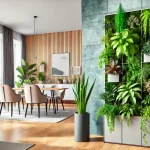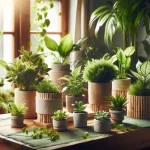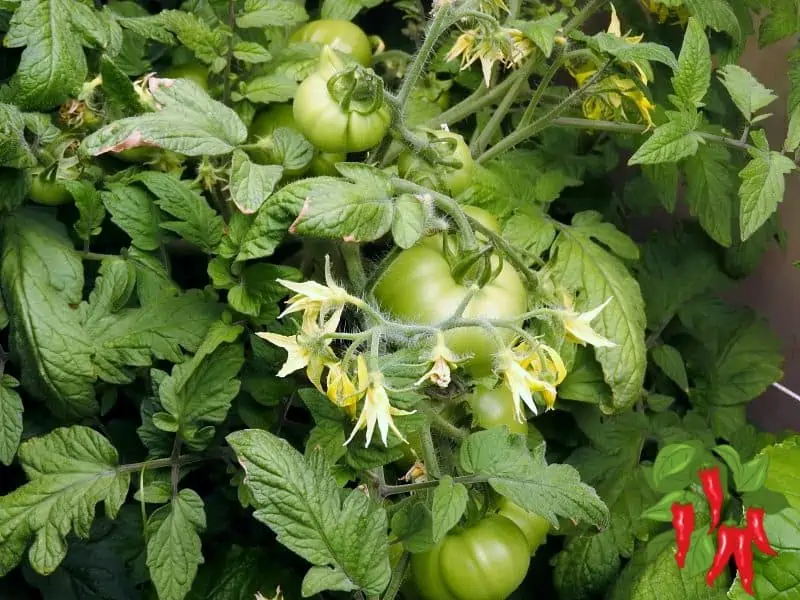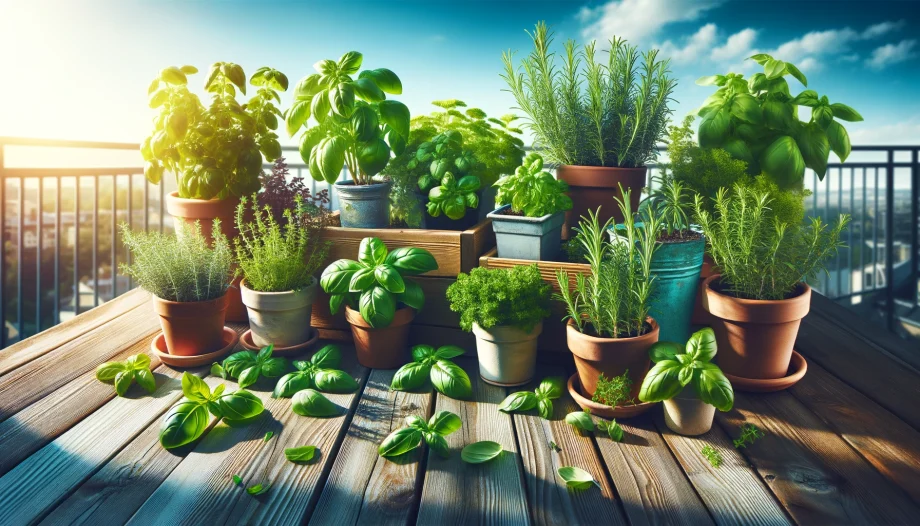This post may contain affiliate links. If you buy something from one of our links we may earn a commission. Thanks
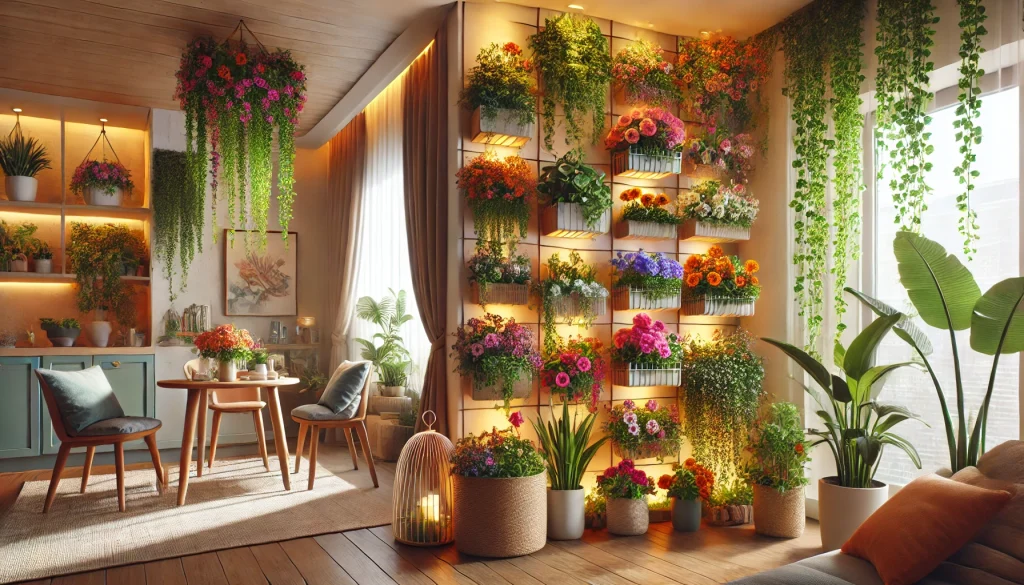
Creating a vertical flower garden indoors might seem like an intimidating task, but it’s easier than you think and a fantastic way to bring greenery into small spaces.
Struggling to find space for your favorite flowers? Vertical gardening solves that problem by allowing you to grow up instead of out.
Let’s explore how you can transform your indoor space into a vibrant vertical garden oasis.
Vertical Flower Garden Indoors Key Takeaways
- Having a vertical flower garden indoors is a creative way to maximize limited space by growing plants vertically.
- Use wall-mounted planters, hanging baskets, or trellises to create a lush, green environment.
- Ideal plants include succulents, herbs, and trailing flowers like petunias.
- This method conserves space and adds beauty to your home.
What is a Vertical Garden?
Howdy everyone! If you’re tight on space but still want a lush green garden, a vertical garden might be just what you need.
A vertical garden allows plants to grow upwards on walls or specially designed structures, making it perfect for small spaces.
This method is super versatile and can be used both indoors and outdoors.
Vertical gardens can range from simple setups with climbing plants on trellises to more complex systems with modular components supporting a variety of plants (The Spruce) (Better Homes & Gardens).
Vertical Flower Garden Ideas

Howdy folks! Looking to brighten up your indoor space with some floral charm? Here are a few creative ideas to get you started with your vertical flower garden indoors:
- Living Walls: Install modular systems on your wall. These systems support various flowers, creating a lush, vibrant wall of blooms.
- Hanging Baskets: Use baskets filled with colorful flowers like petunias or marigolds. Hang them at different heights for a dynamic look.
- Upcycled Materials: Repurpose old items like screen doors or wooden pallets. Attach planters or pots for a unique and eco-friendly garden.
- Trellises: Perfect for trailing plants. Use a trellis to support flowers like clematis or ivy, adding height and interest to your space.
- DIY Projects: Get creative with DIY projects. Build your own planters using materials like gutter gardens or shoe organizers.
These ideas can help you make the most of your space and bring a touch of nature indoors.
Vertical Flower Garden DIY
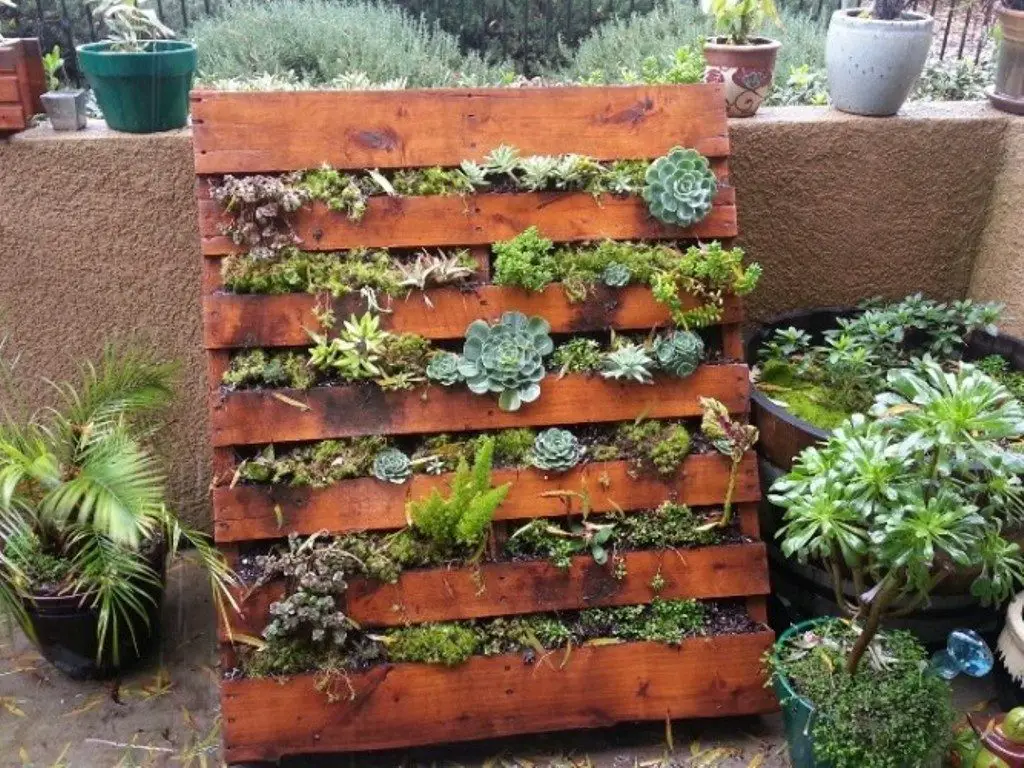
Hey there, DIY enthusiasts! Ready to roll up your sleeves and get creative? Building a vertical flower garden yourself is a fun and rewarding project. Here are some fantastic DIY ideas to help you get started:
Wall-Mounted Planters:
-
- Terra Cotta Pots: Attach terra cotta pots to a wooden frame or directly onto a wall. This classic look is both functional and aesthetically pleasing. You can easily rearrange the pots to change the garden’s appearance.
- Metal Buckets: For a more industrial vibe, use metal buckets. Secure them to a wooden board or a metal grid. These buckets are sturdy and can hold a variety of plants, making them perfect for an indoor vertical garden (The Spruce) (Bob Vila).
Hanging Baskets:
-
- Ideal for Small Spaces: Hanging baskets are perfect for small spaces. They can be suspended from the ceiling or mounted on walls. Use them to grow trailing flowers like petunias, which will cascade beautifully from the baskets.
- Easy to Maintain: These baskets are easy to water and maintain. Just make sure they are securely hung and accessible for regular watering and care (Get Busy Gardening).
Pallet Gardens:
-
- Rustic Look: Wooden pallets are fantastic for creating a rustic vertical garden. Stand a pallet upright and attach planters or pots to the slats. This setup not only saves space but also adds a charming rustic touch to your indoor garden.
- Upcycling: Pallet gardens are also an eco-friendly option, as you can often find old pallets for free or at a low cost. It’s a great way to recycle and create something beautiful for your home (The Spruce) (Better Homes & Gardens).
Gutter Gardens:
-
- Innovative and Functional: Use sections of old rain gutters to create a tiered vertical garden. Mount them on a wall or fence in a staggered pattern to allow plants to cascade down. This method is great for growing herbs and small flowering plants (Get Busy Gardening).
Repurposed Items:
-
- Screen Doors and Ladders: Upcycle old screen doors or wooden ladders by adding planters to them. This approach not only gives new life to old items but also adds a unique focal point to your garden.
- Shoe Organizers: Use hanging shoe organizers with pockets to plant flowers. Hang it on a wall or door, and fill each pocket with soil and your favorite plants. This idea is perfect for small herbs and flowering plants (The Spruce).
By taking on these DIY projects, you can create a personalized and unique vertical flower garden indoors.
Each project offers a chance to get creative and make the most of your space, turning your home into a blooming paradise.
Vertical Flower Garden Plants
When selecting plants for your vertical garden, it’s essential to choose varieties that adapt well to vertical growth and thrive in indoor conditions. Here are some excellent choices to consider:
-
Vining Plants:
- Morning Glories: These vibrant, fast-growing vines can quickly cover a vertical surface, providing a stunning display of color.

- Clematis: Known for their large, beautiful flowers, clematis vines are perfect for adding a splash of color to your vertical garden.

- Ivy: Hardy and easy to grow, ivy can cover walls and trellises, creating a lush green backdrop for other plants (Get Busy Gardening) (Better Homes & Gardens).

- Morning Glories: These vibrant, fast-growing vines can quickly cover a vertical surface, providing a stunning display of color.
-
Compact Flowers:

- Pansies: These cheerful flowers come in a variety of colors and are ideal for adding bright spots to your vertical garden.
- Begonias: With their striking foliage and flowers, begonias are a great choice for indoor gardens. They thrive in low light and add a touch of elegance.
- Marigolds: These hardy flowers are not only beautiful but also help repel pests, making them a practical addition to your garden.
- Petunias: These flowers are perfect for hanging baskets or wall planters, offering vibrant colors and a lovely fragrance.
- Fuchsias: Known for their unique, bell-shaped flowers, fuchsias add a touch of the exotic to any vertical garden.
- Geraniums: Easy to grow and maintain, geraniums provide continuous blooms and are perfect for brightening up vertical spaces.
- Impatiens: Ideal for shaded areas, impatiens offer a variety of bright colors and are perfect for adding a splash of color to your vertical garden (Bob Vila) (Happy Sprout).
-
Herbs:

- Basil: This versatile herb is easy to grow and adds a delightful aroma to your indoor garden. It’s perfect for cooking, too!
- Thyme: Compact and fragrant, thyme is a great herb for vertical gardens. It requires minimal space and is useful in the kitchen.
- Oregano: Another compact herb, oregano is ideal for vertical gardens. It’s hardy and adds a Mediterranean touch to your indoor space (Happy Sprout) (Martha Stewart).
-
Succulents:

- Aloe Vera: Known for its medicinal properties, aloe vera is a low-maintenance succulent that thrives in indoor conditions.
- Echeveria: These rosette-shaped succulents come in various colors and add a unique texture to your vertical garden.
- Sedum: Easy to grow and drought-tolerant, sedum is perfect for adding greenery without requiring much care (Get Busy Gardening).
-
Ferns:
- Boston Fern: This lush, arching fern is perfect for adding a touch of nature indoors. It thrives in high humidity and indirect light.
- Maidenhair Fern: With its delicate, lacy fronds, this fern adds an elegant touch to any vertical garden. It’s ideal for shaded areas (Martha Stewart) (Better Homes & Gardens).
-
Orchids:
- Phalaenopsis (Moth Orchids): These stunning flowers are great for adding an exotic feel to your vertical garden. They thrive in indirect light and can bloom for several months.
- Dendrobium: Another popular orchid variety, Dendrobium orchids are known for their tall, elegant stems and clusters of flowers (Happy Sprout) (Martha Stewart).
Choosing the right plants is crucial for a successful vertical flower garden indoors. By selecting varieties that thrive in vertical setups and indoor environments, you can create a beautiful, vibrant garden that enhances your living space.
Vertical Flower Garden Kit
Hey everyone! If you’re looking for a convenient way to set up your vertical flower garden indoors, a garden kit can be a great solution.
These kits often include everything you need to get started, making the process easy and straightforward.
Here’s what you need to know about vertical flower garden kits:
-
Components of a Kit:
- Modular Panels: Many kits come with modular panels that can be easily assembled and mounted on walls. These panels have slots or pockets where you can place your plants.
- Self-Watering Systems: To reduce the maintenance required, look for kits with built-in self-watering systems. These systems ensure that your plants get the right amount of water without you having to worry about it (Martha Stewart) (Better Homes & Gardens).
- Planter Pockets: Some kits include fabric or plastic pockets that can be attached to walls or frames. These pockets are perfect for holding soil and plants, allowing for easy planting and rearranging (Bob Vila) (Happy Sprout).
-
Ease of Installation:
- User-Friendly Designs: Most kits are designed with ease of installation in mind. They often come with clear instructions and all necessary hardware, making it simple to set up your vertical garden even if you’re not particularly handy (Better Homes & Gardens) (Martha Stewart).
- Flexible Configurations: One of the benefits of using a kit is the flexibility it offers. You can arrange the panels or pockets in various configurations to fit your space and design preferences. This customization ensures that your vertical garden will look exactly how you want it (The Spruce) (Happy Sprout).
-
Plant Selection:
- Suitable Plants: When using a vertical garden kit, it’s essential to choose plants that thrive in vertical setups. Many kits provide recommendations for suitable plants, which often include compact flowers, herbs, and small leafy greens (Martha Stewart) (Get Busy Gardening).
- Growing Medium: Some kits come with a special growing medium tailored to vertical gardening. This medium is often lighter and better draining than regular potting soil, which helps keep your plants healthy and happy (Better Homes & Gardens) (Happy Sprout).
-
Maintenance:
- Built-In Irrigation: Kits with built-in irrigation systems take the guesswork out of watering. These systems can be automated to ensure your plants get the right amount of moisture, which is especially helpful for busy gardeners (Martha Stewart) (Better Homes & Gardens).

- Regular Care: Even with a kit, regular maintenance is still necessary. Be sure to check your plants for pests, trim any dead leaves, and occasionally refresh the growing medium to keep your garden in top shape (Bob Vila) (Happy Sprout).
- Built-In Irrigation: Kits with built-in irrigation systems take the guesswork out of watering. These systems can be automated to ensure your plants get the right amount of moisture, which is especially helpful for busy gardeners (Martha Stewart) (Better Homes & Gardens).
Using a vertical flower garden kit can simplify the process of creating a beautiful indoor garden.
These kits provide all the essential components and make it easy to maintain a thriving garden, even in small spaces.
Whether you’re a beginner or an experienced gardener, a kit can help you achieve a lush, vibrant indoor vertical garden with minimal hassle.
Vertical Garden Maintenance Tips:
-
- Regular Pruning: Keeping your plants healthy and looking their best requires regular pruning. Remove dead or yellowing leaves, trim back overgrown stems, and shape your plants to encourage healthy growth. This helps prevent diseases and keeps your vertical garden looking neat and vibrant.
- Pest Control: Indoor gardens can still attract pests. Inspect your plants regularly for signs of pests like aphids, spider mites, or mealybugs. Use natural pest control methods such as neem oil or insecticidal soap to keep these unwanted visitors at bay (Better Homes & Gardens) (Happy Sprout).
- Plant Rotation: To ensure all plants get equal light and air circulation, rotate them periodically. This is especially important if you have a vertical garden with multiple rows of plants. Rotating plants can also help prevent pest infestations and promote even growth (Almanac.com) (Martha Stewart).
Innovative Vertical Garden Designs:
-
- Smart Watering Systems: Incorporating technology like smart watering systems can make maintaining a vertical garden much easier. These systems can be programmed to water your plants at specific times, ensuring they receive the right amount of moisture without any guesswork. Some advanced systems even monitor soil moisture levels and adjust watering schedules accordingly (Better Homes & Gardens) (Martha Stewart).
- LED Grow Lights: Using energy-efficient LED grow lights can provide the necessary light spectrum for plant growth, especially in areas with limited natural light. These lights can be adjusted to mimic the natural daylight cycle, promoting healthy growth and flowering in your indoor vertical garden (Bob Vila) (Happy Sprout).
- Modular Design Elements: Innovative modular designs allow for easy customization and expansion of your vertical garden. These systems can be adapted to fit any space and can be easily reconfigured as your needs change (Martha Stewart) (Get Busy Gardening).
Vertical Gardening Cost-Benefit Analysis:
-
- Initial Setup Costs: The initial investment for setting up a vertical flower garden can vary depending on the materials and systems you choose. Basic DIY setups using upcycled materials can be very affordable, while high-end kits with built-in irrigation and smart systems can be more expensive (Bob Vila) (Almanac.com).
- Long-Term Savings: Despite the initial costs, vertical gardening can lead to long-term savings. Vertical gardens optimize space, allowing you to grow more plants in a smaller area, which is ideal for urban environments. Additionally, efficient watering systems can reduce water usage, saving on utility bills over time (Better Homes & Gardens) (Martha Stewart).
- Value of Fresh Produce and Flowers: Growing your own herbs, flowers, and even some vegetables can provide significant savings compared to purchasing them from a store. Plus, having fresh, home-grown produce and flowers enhances your living space and contributes to a healthier lifestyle (Happy Sprout) (Get Busy Gardening).
FAQs: Creating a Vertical Flower Garden Indoors
If you’re curious about starting your own vertical flower garden indoors, you’re not alone.
Here are some frequently asked questions that might help you on your journey.
Q. What flowers are good for vertical gardening?
A. Great flowers for vertical gardening include compact varieties like pansies, begonias, and marigolds.
Vining plants such as morning glories and clematis also work well, as do trailing flowers like petunias and fuchsias.
These flowers thrive in vertical setups and add vibrant colors to your garden (Get Busy Gardening) (Happy Sprout).
Q. How do you make a vertical flower garden?
A. To make a vertical flower garden, start by selecting a suitable structure like wall-mounted planters, hanging baskets, or a trellis.
Choose plants that are well-suited for vertical growth and ensure they get enough light and water.
Using a vertical garden kit can simplify the process by providing all necessary components (The Spruce) (Bob Vila).
Q. Are there any drawbacks to using vertical gardens?
A. While vertical gardens are space-efficient and beautiful, they can require more maintenance than traditional gardens.
Regular pruning, pest control, and ensuring adequate light and water are essential.
Additionally, vertical gardens can be heavier, so make sure your structure can support the weight (Martha Stewart) (Better Homes & Gardens).
Q. What are three types of vertical gardens?
A. The three main types of vertical gardens are:
- Living Walls: Modular systems with plants growing in soilless mediums or pockets.
- Trellis Systems: Structures supporting vining plants that grow upwards.
- Container-Based Vertical Gardens: Wall-mounted or hanging containers holding individual plants (Get Busy Gardening) (Better Homes & Gardens).
Q. Are vertical gardens hard to maintain?
A. Vertical gardens do require regular care, including watering, pruning, and pest management.
However, using systems like drip irrigation and self-watering pots can significantly reduce maintenance efforts.
Grouping plants with similar needs also helps simplify care (Martha Stewart) (Better Homes & Gardens).
Q. Are vertical gardens worth it?
A. Absolutely! Vertical gardens maximize space, making them ideal for small indoor areas.
They also enhance the aesthetic appeal of your home and can even improve air quality.
The initial setup may require some investment, but the long-term benefits and enjoyment make it worthwhile (Better Homes & Gardens) (Martha Stewart).
I hope these answers help you feel more confident about creating your own vertical flower garden indoors. Happy gardening.
Creating a Vertical Flower Garden Indoors Conclusion
Howdy everyone! We’ve covered a lot of ground on creating a vertical flower garden indoors.
This gardening method is not only space-efficient but also brings a splash of greenery and color into your home.
Let’s wrap up with some final thoughts and key takeaways.
Benefits of a Vertical Flower Garden Indoors
Creating a vertical flower garden indoors comes with numerous benefits. It maximizes limited space, adds aesthetic appeal, and can even improve indoor air quality.
By using creative DIY methods or convenient garden kits, you can transform any small space into a vibrant garden oasis.
Tips for Vertical Gardening Success
To ensure your vertical garden thrives, remember these tips:
- Light and Watering: Provide adequate light, either natural or through grow lights. Consistent watering, possibly with the help of drip irrigation or self-watering pots, is crucial for plant health.
- Choosing the Right Plants: Opt for plants that are well-suited for indoor conditions and vertical growth. Vining plants, compact flowers, herbs, succulents, and ferns are excellent choices (Better Homes & Gardens) (Martha Stewart).
DIY vs. Kits
Whether you prefer the creativity of DIY projects or the convenience of pre-made kits, both options have their advantages. DIY projects allow for personalization and can be cost-effective, while kits offer ease of installation and comprehensive solutions for beginners (The Spruce) (Happy Sprout).
Vertical Gardening Key Takeaways
- Space Efficiency: Vertical gardens make the most of limited indoor space.
- Plant Selection: Choose plants that thrive in vertical setups and indoor environments.
- Maintenance: Regular pruning, pest control, and proper watering are essential.
- Innovative Solutions: Consider using smart watering systems and modular designs for ease of maintenance and customization.
- Cost Considerations: Initial setup costs can vary, but long-term savings on space and water make vertical gardens worthwhile.
I hope this guide has inspired you to create your own indoor vertical flower garden.
Happy gardening, and remember to keep it green! See y’all next time!
Visit my Amazon Influencer Page for videos and gardening products Grow Your Own Garden














![LetPot Automatic Watering System for Potted Plants, [New Wi-Fi & App Control] Drip Irrigation Kit System, Smart Plant Watering Devices for Indoor Outdoor, Water Shortage Remind, IPX66, Green LetPot Automatic Watering System for Potted Plants, [New Wi-Fi & App Control] Drip Irrigation Kit System, Smart Plant Watering Devices for Indoor Outdoor, Water Shortage Remind, IPX66, Green](https://m.media-amazon.com/images/I/51nD53Lk9TL._SL500_.jpg)
